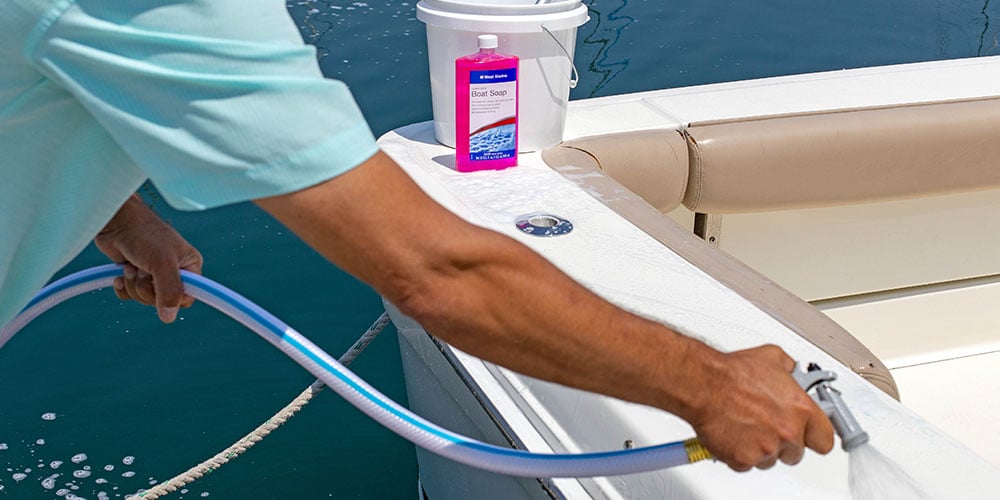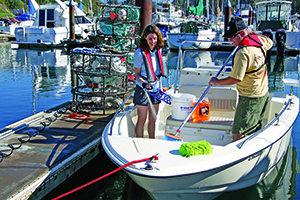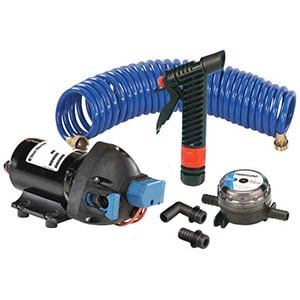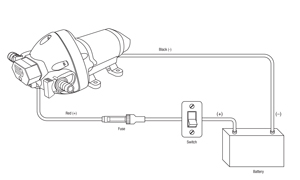

A washdown system helps you clean up the boat after a day on the water.
An onboard washdown system provides a convenient means to hose down the deck after a day of boating. Clean up your cockpit after landing a big fish, rinse off the muddy anchor rode as it’s raised by your windlass, or hose off seagull indiscretions and rinse the decks after a scrub down.
Washdown System Components
Washdown systems include a 12V DC pump with an integral pressure switch, a hose and nozzle, an inline filter, wiring, circuit protection and connectors.
Pump Water Pressure
Pump capacity is rated in gallons per minute (gpm). A diaphragm pump in the 3.4gpm to 5gpm range meets the needs of most small and medium-sized boats, generally providing pressures in the 35-50psi range, roughly equivalent to 35-50% of “city water” pressure.
Pump Installation Options
Install your pump in an out-of-the-way but accessible location. Locate the pump above the high-water mark of the bilge, although most of these pumps are designed for use in wet locations. Washdown pumps are often installed in a protected location under a boat’s gunwale or in a cockpit locker.

Our 4.0GPM Washdown Pump Kit is great for general washdown of the deck and bait stations and includes the pump, a hose, spray nozzle and quick connect hose fittings.
To supply the pump with seawater, you’ll need to tee into an existing seawater line—or install a separate thru-hull and seacock. You will need 1/2" or 3/4" reinforced inlet hose, 1/2" or 3/4" outlet hose (minimum 100psi burst strength), hose clamps, and an in-line strainer between the seacock and the pump to keep debris out of the pump. An optional component is an accumulator tank, which installs downstream from the pump. Accumulator tanks smooth out water delivery and allow the pump to cycle on and off less frequently.
Hose Installation Options
Once you have installed the pump, you have a variety of options. In the simplest installations, a garden hose with a trigger nozzle is threaded directly to the pump outlet. Energize the pump and use the hose as if it were connected to dock water. To facilitate this type of installation, Jabsco and SHURflo offer washdown pumps with Quick-Connect ports, which permit quick engagement and disengagement of the hose at the pump outlet.
Self-coiling hoses are a popular, lighter and more compact alternative to a heavy garden hose. Some owners plumb the outlet line to a garden-hose-style faucet, which they use to control the flow of water on deck. Check out HoseCoil’s Quick Release System, which includes an outlet fitting that flush mounts to a bulkhead. Used with one of their self-coiling hoses, the system permits quick engagement of the hose for use, and quick disengagement for storage. The slickest installations are self-coiling hose enclosures that plumb directly to the pump. These enclosures neatly store the hose and keep it out of the way but ready for use.

Simple installation with switch and in-line fuse.
Wiring and Switches
If the pump draws less than 10 amps, AWG 14 wire can be used for runs up to 10' (breaker panel to pump) with less than a 3% voltage drop. For longer wire runs or pumps with a higher amperage draw, follow the manufacturer’s recommendations.
We suggest you wire the pump to your boat’s electrical distribution panel. (If no panel exists, now might be a good time to install one.) For convenience, install a waterproof On/Off switch near the pump.
Use only marine-grade wire and connectors that have been tinned to prevent corrosion. All connections should be crimped, using a crimping tool designed for this purpose. To guard against water intrusion and corrosion all connections should be protected with adhesive-lined shrink wrap tubing. The circuit should be fused or protected with a breaker per the manufacturer’s recommendation.
Once you have installed your washdown system and begun to experience the convenience that these systems offer, you’ll wonder how you managed to do without it!